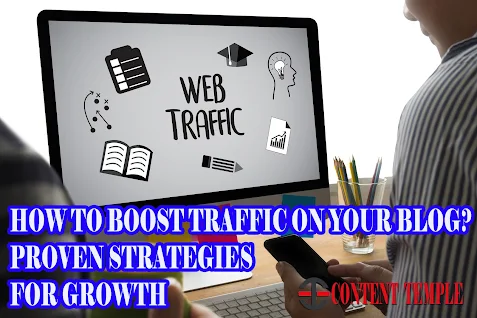If you’re running a blog—whether for personal expression, business, or monetization—you know that traffic is everything. Without readers, even the best content remains unnoticed. Fortunately, increasing blog traffic is achievable with a thoughtful strategy that combines content quality, search engine optimization (SEO), social media promotion, and consistent engagement. In this article, we’ll explore proven methods to grow your blog traffic and keep it rising over time.
1. Produce High-Quality, Valuable Content
At the core of any successful blog is content that resonates with readers. The more useful, entertaining, or informative your blog posts are, the more likely people are to share and revisit them.
Tips for creating great content:
a. Solve problems: Identify your audience's pain points and provide practical solutions.
b. Be original: While it’s okay to cover popular topics, aim to provide unique insights or personal experiences.
c. Write clearly: Use straightforward language, short paragraphs, and subheadings for easy readability.
d. Use visuals: Include images, infographics, or videos to break up text and enhance understanding.
2. Master SEO (Search Engine Optimization)
SEO is the key to organic (unpaid) traffic. When your blog ranks well on search engines like Google, you attract a steady stream of visitors without spending on ads.
SEO Essentials:
a. Keyword research: Use tools like Google Keyword Planner, Ahrefs, or Ubersuggest to find terms your audience is searching for.
b. On-page SEO: Optimize title tags, meta descriptions, headers (H1, H2), and image alt text with your target keywords.
c. Internal linking: Link to your own related blog posts to keep readers engaged and help search engines index your site better.d. Mobile-friendly design: Ensure your blog is responsive and loads quickly on all devices.
e. Backlinks: Gain links from reputable websites to improve your domain
authority and rankings.
3. Leverage Social Media Platforms
Social media is one of the most powerful tools for driving traffic to your blog. By sharing content on platforms where your target audience hangs out, you expand your reach significantly.
Best practices for social media:
a. Choose the right platforms: Don’t try to be everywhere. Focus on platforms like Twitter, LinkedIn, Instagram, or Pinterest depending on your niche.
b. Create shareable content: Use catchy headlines, engaging visuals, and concise captions to grab attention.
c. Engage with followers: Respond to comments, participate in conversations, and build a community around your blog.
d. Use hashtags strategically: Helps new users discover your content.
e. Automate when possible: Tools like Buffer, Hootsuite, or Tailwind can schedule posts and analyze performance.
4. Email Marketing and Newsletter Growth
An email list is a powerful asset. It allows you to communicate directly with your most loyal readers, promote new posts, and drive consistent traffic.
Grow and use your email list effectively:
a. Offer a lead magnet: Create a free eBook, checklist, or resource to encourage sign-ups.
b. Use pop-ups and inline forms: Make it easy for visitors to subscribe.
c. Send regular updates: Share your latest blog posts, special content, and personalized recommendations.
d. Segment your list: Tailor your messages to different audience groups for better
engagement.
5. Guest Blogging and Collaborations
Writing for other blogs (guest posting) and collaborating with influencers or fellow
bloggers helps you tap into new audiences and build credibility.
How to get started:
a. Pitch to relevant blogs: Choose those with strong traffic and authority in your niche.
b. Provide high-quality guest content: Treat guest posts with the same care as your own blog.
c. Include a link back to your blog: Typically allowed in your author bio or within the post (check guidelines).
d. Partner with influencers: Even small collaborations (like co-authored posts or shoutouts) can boost visibility.
6. Repurpose and Update Old Content
Don't let your older posts fade into obscurity. Updating and repurposing content can bring new traffic without creating entirely new articles from scratch.
Ways to revitalize content:
a. Update statistics and links: Keep information accurate and relevant.
b. Improve SEO: Re-optimize keywords, meta tags, and readability.
c. Create different formats: Turn a blog post into a video, infographic, or podcast episode to reach new audiences.
d. Reshare on social media: Especially if the content is evergreen (relevant over
time).
7. Engage in Blogging Communities and Forums
Becoming an active member in blogging or niche-specific communities can help increase traffic through relationship-building and content promotion.
Places to engage:
a. Reddit: Find relevant subreddits and join discussions.
b. Quora: Answer questions related to your niche and link to your blog when appropriate.
c. Medium and LinkedIn: Republish posts or write exclusive pieces that direct readers back to your blog.
d. Facebook Groups and Online Forums: Share content where allowed and contribute meaningfully to conversations.
8. Use Analytics to Refine Your Strategy
Tracking performance is essential to knowing what works and what doesn’t. Use tools like Google Analytics and Search Console to gain insights.
Metrics to monitor:
a. Traffic sources: Where are your readers coming from?
b. Popular posts: What content attracts the most visitors?
c. Bounce rate and time on page: How engaged are your readers?
d. Conversion rate: How many readers sign up for your email list or take desired actions?
Based on this data, tweak your content strategy, posting frequency, and promotional efforts.
Final Thoughts
Growing blog traffic doesn’t happen overnight, but with consistency, quality, and a well-rounded strategy, the results will come. Start with content that adds genuine\ value, optimize for search engines, and promote it across channels. Over time, your blog will not only attract more readers but also build a loyal community. Remember: the most successful bloggers aren’t necessarily the ones who write the most—they’re the ones who write well, promote smartly, and never stop learning.






0 Comments